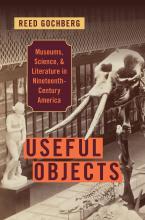
In Useful Objects: Museums, Science, and Literature in Nineteenth-Century America, Reed Gochberg offers an engaging analysis of informational institutions during a period of change across the nineteenth century. Gochberg, whose background is in American literature and culture, draws from a variety of sources, including children's literature, travel guides, and newspaper advertisements, in order to show the breadth of nineteenth-century people's thinking and writing about collection and presentation practices related to the newly conceptualized exhibition and research space. Each chapter in Useful Objects takes a different museum, broadly defined, as its main subject, interweaving the writings and activities of those involved with these museums within broader discussions of knowledge production and dissemination during Gochberg's identified time period.
The first chapter, "Circulating Objects: Loss and Decay in the American Philosophical Society's Cabinet," focuses on the American Philosophical Society's early history and key players. The society's collections, global in origin, were subjected to both political instability and deterioration due to circulation and neglect. Referencing J. Hector St. John de Crèvecoeur's writings about the impermanent materiality of museum objects and Charles Wilson Peale's public museum in Philadelphia, Gochberg explicates the issues that the American Philosophical Society negotiated when developing a public institution that would house permanent collections for study.
The second chapter, "Shadowed Silhouettes: Writing Indigenous Resistance in Early American Museums," details the presence of Native Americans both in and around museums in the nineteenth-century United States. Peale's silhouettes of a delegation of Native Americans visiting his Philadelphia Museum, newspaper accounts of delegation visits, and the writings of Jane Johnston Schoolcraft, an Ojibwe poet, and her husband, Henry Rowe Schoolcraft, an ethnologist and federal agent, are read by Gochberg through a subversive lens in order to highlight both the resistance that Native Americans showed toward settler practices of collection and exhibition and the historically overlooked, multifaceted responses of Native Americans to museums and their collections.
"American Claimants: Overwhelming Collections and Visitor Impressions at the British Museum," the third chapter, shifts from examining museums in an American context to the encounters Americans had abroad with museums. In the midst of the British Museum's crisis of identity and overabundance of items, American authors such as Nathaniel Hawthorne, influenced by the excess and imperialist representations in the [End Page 119] museum, reflected their concerns with the process of sorting through collections in order to identify items of historical and national significance in their writing. Simultaneously, Orra White Hitchcock, an artist and naturalist, and William Wells Brown, a formerly enslaved abolitionist, produced written accounts of their visits that reveal their attempts to defy curatorial interpretations in favor of their own intellectual engagement.
In chapter 4, "Novel Inventions: Nation and Spectacle in the U.S. Patent Office Gallery," Gochberg compellingly presents the US Patent Office gallery as an unconventional museum in both scope and purpose. Designed to showcase inventions for both public awe and original value, the gallery gained national significance as a testament to progress and innovation in the United States. While Ralph Waldo Emerson took up the Patent Office's concerns about how to determine original ideas, descriptions of women working in the office, as well as accounts in abolitionist papers, revealed that the labor and ideas of women and enslaved people often went unacknowledged. The chapter concludes with an analysis of Walt Whitman's writing relating to the use of the office as a hospital during the Civil War, where the convergence of war and innovative representations revealed the human cost of progress.
The fifth chapter, "Specimen Collectors: Preservation and Classification at the Harvard Museum of Comparative Zoology," challenges the norms of suspension and natural order promoted by the museum's primary advocate, zoology professor Louis Agassiz. Henry David Thoreau, an early specimen donor to the museum, continued to express discomfort with killing or damaging nature for the sake of study, while a young Henry James, assistant to Agassiz, resisted rigid categories in the museum in favor of embracing the unusual. Children's writers, including Agassiz's wife, Elizabeth Cabot Cary, who also wrote about their expeditions, and Louisa May Alcott troubled the divides between the domestic sphere reserved for women and the professional sphere of the museum they were often left out of.
Useful Objects concludes with William J. Wilson's 1859 series of the Afric-American Picture Gallery to turn toward imagined possibilities for the future of museums. Although Wilson's fictional museum, much like the real-life museum created by Benjamin Kent that begins the book, was intended for educational purposes, it did not follow in the legacy of Kent's museum and others like it, which were imbued with narrow understandings of what was "worthwhile" information to collect, study, and display and which achieved these limited goals through imperialistic and discriminatory practices.
Gochberg convincingly argues for the importance of studying nineteenth-century museums, for it is through this study that broader understandings of classification, interpretation, engagement, and preservation practices and beliefs of the time are revealed. Furthermore, Useful Objects gives due credit to the people who developed these practices and beliefs, with considerations of differences in gender, race, and profession. Not only does Gochberg include voices typically left out of nineteenth-century museum studies, but she also critiques the racist and sexist practices of the white men who were (and continue to be) held up as founders and experts of the field. For Gochberg, by considering different types of engagement with the nineteenth-century museum and looking beyond the walls of the museum itself, museums today can continue to challenge normalized notions of "useful knowledge," pursuing interdisciplinary and novel forms of collaboration and access between and across museum objects and their users. [End Page 120]
—Emma Hetrick, University of Texas at Austin

